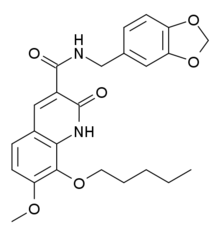JTE-907
 | |
| Systematic (IUPAC) name | |
|---|---|
|
N-(benzo[1,3]dioxol-5-ylmethyl)-7-methoxy-2-oxo-8-pentyloxy-1,2-dihydroquinoline-3-carboxamide | |
| Clinical data | |
| Legal status |
|
| Identifiers | |
| CAS Number |
282089-49-0 |
| PubChem | CID 9867770 |
| ChemSpider | 8043461 |
| Chemical data | |
| Formula | C24H26N2O6 |
| Molar mass | 438.472 |
| |
| |
| (verify) | |
JTE-907 is a drug used in scientific research that acts as a selective CB2 inverse agonist.[1][2] It has antiinflammatory effects in animal studies,[3] thought to be mediated by an interaction between the CB2 receptor and IgE.[4]
See also
References
- ↑ Iwamura, H; et al. (2001). "In vitro and in vivo pharmacological characterization of JTE-907, a novel selective ligand for cannabinoid CB2 receptor". The Journal of Pharmacology and Experimental Therapeutics 296 (2): 420–5. PMID 11160626.
- ↑ Raitio, KH; et al. (2006). "Synthesis and SAR studies of 2-oxoquinoline derivatives as CB2 receptor inverse agonists". Journal of Medical Chemistry 49 (6): 2022–7. doi:10.1021/jm050879z. PMID 16539390.
- ↑ Ueda, Y; et al. (2005). "Involvement of cannabinoid CB(2) receptor-mediated response and efficacy of cannabinoid CB(2) receptor inverse agonist, JTE-907, in cutaneous inflammation in mice". European Journal of Pharmacology 520 (1–3): 164–71. doi:10.1016/j.ejphar.2005.08.013. PMID 16153638.
- ↑ Ueda, Y; Miyagawa, N; Wakitani, K (2007). "Involvement of cannabinoid CB2 receptors in the IgE-mediated triphasic cutaneous reaction in mice". Life Sciences 80 (5): 414–9. doi:10.1016/j.lfs.2006.09.026. PMID 17055000.
This article is issued from Wikipedia - version of the Friday, February 05, 2016. The text is available under the Creative Commons Attribution/Share Alike but additional terms may apply for the media files.